|
Neil Peart ― Discography: Rush
On this page, you'll find each studio album Neil
Peart has
played on with Rush as well as notes about the music, lyrics, and drumming. I've left off
all compilations. If you want to
see everything Rush has released, go here.
A note on the reviews: Reviewing Rush albums
against other Rush albums is a difficult task; each album is unique and has
strengths and weaknesses. But in the end some stand out more than others.
Feel free to let me know if you agree or
disagree.
Fly By Night - Andyo rating: 3 stars out of 4
Released in February 1975
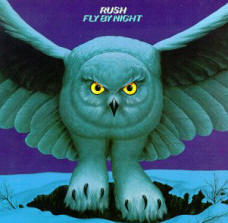
This is Neil's first album with Rush, but you
wouldn't know it by the sound of things. The album opener Anthem begins
with a bang, introducing the sound that would define Rush: Intricate rhythms of
hard-rocking, precise playing. Anthem's opening salvo contains some amazing beats;
Neil starts on
the snare and bass drum, and then sets up a groove on the hi-hat with some wicked, syncopated
bass drum drumming.
As if that wasn't enough, there's By-Tor and
the Snow Dog and those three machine-gun drum solos that are very, very hard
to play. I often remind myself that Neil was 21 years old when
he was making this stuff up―no ordinary drummer.
Caress of Steel
- Andyo rating: 2-1/2 stars out
of 4
Released in September 1975
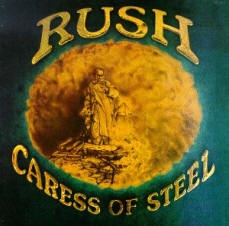
It's ironic this album is called "Caress of
Steel," an allusion to "Heavy Metal." At times the songs seem to get buried in
the production, losing their aggressiveness and power. This is definitely an
album where Rush is experimenting and trying to find its voice.
Even so, "Caress of Steel" comes up with many Rush
classics, including Bastille Day, Lakeside Park, and The Fountain of Lamneth.
The latter expands on the J.R.R. Tolkien-themes explored in By Tor and the Snow Dog and
pushes them into a side-long epic, a musical form that shows up again on other Rush albums.
On Didacts and Narpets, you can hear many
drum patterns that would find their way into Neil's drum solos on "All the World's a
Stage" and "Exit... Stage Left."
2112 - Andyo rating: 3-1/2 stars out
of 4
Released
in March 1976

The story goes that the record company heard Rush was
writing a side-long sci-fi epic and tried to stop it from happening.
According to Neil, the band stuck to its guns and did what they wanted. And it
became the breakout album for Rush. The band had found its voice and had established its
audience. Gone were the days of touring in a rented station wagon pulling a
U-haul.
The 2112 Suite (side one for those who bought the
record) begins with the Overture―chock-full of aggressive, stop-and-go rhythms that lead perfectly into
The Temples of Syrinx. It's such a perfect segue, Rush has never
played one song without the other.
The drumming throughout the 2112 Suite is
powerful and creative, matching the music at every turn. I've always been
particularly stunned by the percussive pyrotechnics in The Grand Finale. To
hear Rush's later versions of this in a live setting (especially around the "Moving
Pictures" tour) is mind-blowing.
Side two of "2112" has a lackluster version of A
Passage to Bangkok, as well as some of my least-favorite Rush songs of all time:
Tears and The Twilight Zone. It's as if the band had put all its energy into
that first side, which is fine with me.
All
the World's A Stage - Andyo rating: 3-1/2 stars out
of 4
Released
in September 1976
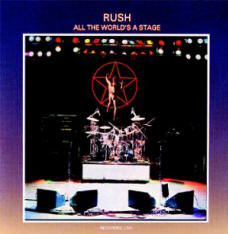
Massey
Hall, 2112 Tour, 1976. What I'd have given to have been there. This is a sonic
snapshot of the Rush in 1976, where they seem most comfortable: on the
stage, playing for an audience. While the band had already shown
amazingly-precise studio chops, their live performance brings out the groove
that was sometimes buried in lush overdubs. We get to hear the band,
warts-and-all, and they sound better than their studio albums.
In
particular, By-Tor and the Snow Dog and In the End seem emotionally charged
and fresh. The medley that includes Working Man, Finding My Way, and the
now-famous Neil "Professor" drum solo show how much the band has matured in their
approach, with new rhythmic interplay between Geddy and Neil.
This is a fine record of a band on their way up.
A
Farewell to Kings - Andyo rating: 3 stars out
of 4
Released
in September 1977
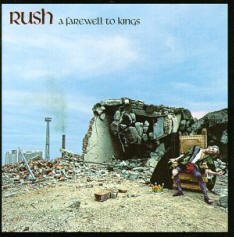
One of the most prominent themes in Rush lyrics is change―and
change they do on "A Farewell to Kings." Not content to continue playing the same
type of aggressive rock and roll, they explore new territories of sound.
On this
album, keyboards play a more prominent melodic role in songs like A
Farewell to Kings and Xanadu. Neil also experiments with new
percussion: Tubular bells, bell trees, triangles, and anything else he can get
his hands on. (Neil once called his use of percussion during this time "musical greed.")
Neil's creativity and new confidence is especially evident on
songs like A Farewell to Kings, Xanadu, and Cygnus X-1. He
moves fluidly in and out of odd time signatures. The light rolls and hi-hat work
he plays in the solo section of
A Farewell to Kings is extremely smooth, and then he switches into a rock/jazz
fusion when the guitar solo begins.
Hemispheres - Andyo rating: 4 stars out
of 4
Released
in October 1978

For me, this
is the
album where Rush―and Neil in particular―nailed what they were after. The
musicianship is more confident, the production clear and crisp. And there's
not a wasted song. Neil once said that the first 7 or 8 Rush albums were
"experimental," and with this in mind you can see the vision coming into focus
with this album.
"Hemispheres" continues
where Cygnus X-1 left off. It's another concept piece that captures the
cinematic quality of the band at its best. Yes, it's cerebral (literally) and
pretentious, but the music is always rocking at a level that seems
unattainable to most other musicians.
For all the
seriousness on "Hemispheres," this record contains one of Rush's finest
instrumentals, La Villa Strangiato. Based on Alex Lifeson's dreams, the
11
movements in this song take us through rock, jazz, fusion, cartoon music (listen
to the section titled "Monsters!"), and everything in between. Neil said that this
song was so hard, he couldn't play it in one take in the studio.
Also on this album are Circumstances and The Trees. The latter has
become an anthem of sorts, I suppose, for its simplistic imagery.
It should be noted
that "Hemispheres" is where Neil introduced much of his modern
repertoire, including the propulsive cymbal bell ride pattern.
Permanent Waves - Andyo rating: 4 stars out
of 4
Released
in January 1980

If "Hemispheres" was any indication of where things were going
with Rush, then "Permanent Waves" is the logical follow-up. Gone are the side-long
epics, replaced by shorter, catchier songs that contain as much, or more,
complexity and creativity.
The album contains two of Rush's gems, The Spirit of Radio and
Freewill. Both contain displays of amazing musical chops and bring to the forefront a
new sense of melody. The opening of The Spirit of Radio is a tour de force, with the
guitar playing a repeating rhythm over bass and drum interplay. How they come
together at the has always been a mystery to me. The song, written as a tribute
to a Toronto radio station, CFNY, sweeps through different movements that include rock, New
Wave, and Reggae. There are references to Simon and Garfunkel
lyrics ("The words of the prophets are written on the studio wall.") This is a
perfect Rush song―probably my favorite of all time.
And then there's Freewill. Time change after time change, yet
it doesn't feel odd. In the solo section, each member of the band releases a
firestorm of chops that causes crowds in Rio de Janeiro to literally bow down.
(Note: The beat
and tempo in Freewill's verses are very similar to Tom Sawyer's groove.)
Jacob's Ladder is a song about an atmospheric
image (when the
sun slashes through the clouds), and the results are soundtrack-like.
Neil's rudimentary snare work at the beginning of this song is particularly interesting, as is the
synthesizer interlude before the final movement.
For most bands, that would be enough―but Rush throws in
Entre Nous, Different Strings, and the classic Natural Science (another short
epic, like Jacob's Ladder).
Moving Pictures - Andyo rating: 4 stars out
of 4
Released
in February 1981

This was the first Rush
album to go multiplatinum, and brought the band to the attention of
millions of new fans (myself included). All the elements that Rush had been
working on since Hemispheres coalesced on "Moving Pictures" to form something interesting and noteworthy
to popular culture.
On this album are some
of the best songs Rush has written, Tom Sawyer, Red Barchetta, YYZ, Limelight,
and The Camera Eye.
Neil's creativity
soars, from the groove on
Tom Sawyer, to the
drum solo-like fills leading out of
the solo section. Lyrically, there are existential explorations into the meaning
of fame in Limelight, and observations of walking around two very different
cities in The Camera Eye (New York and London). There's the magic
of YYZ and its Toronto airport-inspired Morse code rhythm that starts off the
song. Everything about the album works, but most of all I like the production.
Everything is clear and crisp. (Neil wore a microphone taped to his chest to get
the "drummer's perspective"; I often wonder if this is how they got the drums to
sound so good.)
If I had to pick one
Rush album to recommend, this is it. One other thing
that I love about Moving Pictures is the way Vital Signs heralds a new
direction for the band. You can almost hear this song playing on Signals.
Exit... Stage Left - Andyo rating: 4 stars out
of 4
Released
in October 1981
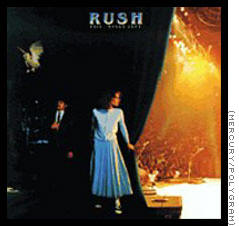
After four studio albums, it was time for the band to do
another live album. This one is made up of the "Permanent Waves" and "Moving
Pictures" tours. The stars lined up for the band on this release, as this
album ended up being a "greatest hits" release right when Rush soared in
popularity. "Exit... Stage Left" introduced new fans to the best of the Rush
catalog in a live setting, where the band shines.
The Spirit of Radio leads things off right (still my favorite
version of the song). There's the sing-along in Closer to the Heart, and a great
version of Jacob's Ladder.
I still remember going to get this album. I rode my bike in
the dark for miles to the record store. Then, sweating
and tired, I listened to the entire album in one sitting. One of my strongest memories of that night is being somewhat
frightened by the spooky first section of Xanadu, only to be elated
during the
next section where Neil plays his melodic cowbells along with Alex's guitar riff.
I
also wondered how these three guys could make so much sound? Geddy Lee once
called Rush "the world's smallest orchestra," and that about sums it up. But it makes
for a challenging night, especially for Geddy. He plays bass and also has to sing
(no small feat); but then he also plays keyboards with his hands and keyboard
pedals with his feet. But when I first listened to this album, I had no idea how
they did it all.
"Exit... Stage Left" also contains the drum solo that made
Neil Peart a household name. It's still one of his best solos. He lays down
exquisite snare work that would make Buddy Rich proud, as well as those humorous
cowbells. By the time he's done playing, he's pretty much re-defined the modern
drum solo. This is music, not just drums. There are movements and themes. It's
entertaining. He makes the drum solo accessible to non-drummers, following in
the footsteps of Gene Krupa and Buddy Rich.
Signals - Andyo rating: 4 stars out
of 4
Released
in September 1982
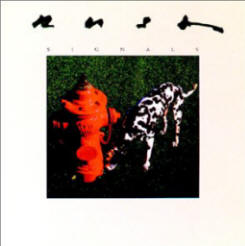
"Signals" was such a
radical change in direction for the band, a change I didn't like it at first. Gone
were the power chords on the guitar, replaced by keyboards. Lots of keyboards.
But when you listen
closely, Rush is actually playing the same style of music they were playing on
"Moving Pictures," only it's with keyboards and rhythm guitar. Neil's drumming is
still creative on every song. The sequencers
haven't taken over yet (for more on that, see "A Show of Hands").
I'm sure
Rush lost a lot of fans with album, but they kept me. The Original Recordings Remaster of "Signals" is
especially good, bringing out the guitar a little more.
There are fantastic
drum details on every song on this album. Neil brought his "double-hand ride
technique" to the forefront on
Subdivisions, giving the song a smooth, even
feeling. The fills that end the song are trademark Peart. The Analog Kid is one
song where the guitar jumps out, and remains a favorite of many Rush fans I
know. I also think
The Digital Man (one of the only Rush songs to swing) is an
amazing display of chops and subtlety.
There are also two B-side gems worth noting: The Weapon, which would radically influence Neil's playing on
upcoming albums (listen to the bass drum) and Losing It. The latter is a
heartfelt song that includes a moving portrait of Ernest Hemingway (the Writer in the
song).
Grace Under Pressure - Andyo rating: 4 stars out
of 4
Released
in April 1984

In many ways, this is one of Neil's finest creative efforts. The
drumming is extremely interesting, and the lyrics have achieved a level of
maturity that is literary.
The title "Grace Under Pressure" is an allusion to Ernest
Hemingway, whose characters often exhibited these traits. Also sprinkled
throughout are other phrases from the period of the Golden Age of literature like "lost generation," "Brother, can you
spare?" and "Absalom." The lyrics in Red Lenses are a blend of T.S. Eliot
and e.e. cummings.
On the drumming front, Neil added a satellite electronic drum
kit that introduces a new palette of sounds, most evident in Red Sector A
and Red Lenses. Samples fire off in many songs, even when he's
playing the acoustic kit.
This album continues the changes that started on
"Signals." For example,
Red Lenses is a major departure, both
musically and lyrically. When I first heard the keyboard melody in the
middle section, I thought Rush had lost it. You just don't hear dance rhythms
and disco in a Rush song. Well, now it's one of my favorite Rush songs.
You also have to admire the cover for this album
by Hugh Syme―definitely
one of my favorites.
Power Windows - Andyo rating: 4 stars out of 4
Released
in October 1985

I was in
college when "Power Windows" released, and it seemed to take the world by storm.
The song The Big Money had a lot to do with it, with its pop sensibility and
melodic hooks. I remember that my college roommate used to listen to a Seattle pop
station that played U2 and The Cure, and when The Big Money showed up there, I knew things had changed.
"Power
Windows" does a better job of mixing in the keyboards with all the power the
band can produce. When you compare the two albums, "Grace Under Pressure" ends up
sounding a little thin. This was Peter Collins'
first effort producing Rush, and from the results he seemed to really
connect with the band.
The Big
Money is an amazing song, fusing what was great about Rush in the past to their
new approach. I love the hi-hat and cowbell work on the drums throughout the
song. There are
drum details hidden in the song, too, like the sample of coins jingling. And if
you listen close, Neil's using a "clap trap" sample throughout the song to
accentuate the snare sound.
This
album burns from beginning to end with amazing drum details. In particular, the
beat for Mystic Rhythms with its consistent African-inspired rhythm, the ending
cymbal chokes in Grand Designs (a spontaneous act by Neil in the
studio), and the powerful Middletown Dreams. There's a consistency in the songs
that we haven't heard since "Moving Pictures."
Hold Your Fire - Andyo rating:
2-1/2 stars out
of 4
Released
in September 1987

If there's an album
where Rush started lose a bit of its soul, it's this one. The melody and
keyboards start to overpower the three-piece sound that was so integral to the
band.
Some people feel this
is Rush's finest work. There are beautiful melodies everywhere on this album,
but it's at the expense of some intensity. During the "Permanent Waves" through
"Signals" time frame, the music and the singing had played equal parts, but on
"Hold Your Fire"
the singing started to outweigh the music. There are still some interesting results,
like Force Ten, Time Stand Still, and Prime Mover. There's the introspective
Tai
Shan and Mission. There's a wicked bass line in Turn the Page. But somehow, in
retrospect anyway, it
doesn't add up like some of the earlier efforts.
The band
became too controlled on this album, too safe. Force Ten was written as
an afterthought, after all the other songs were done, and it probably should
have been where they started.
A
Show of Hands - Andyo rating:
2-1/2 stars out of 4
Released
in January 1989

On the day this album
came out, I remember sitting
down with my brother and listening to it on CD. I remember thinking that it
sounded like machines were playing the music instead of three human beings. The sequencers
had finally taken over; the band had lost its groove,
its soul.
Certainly, it was nice
to hear some of the live versions of these songs. In the past, Rush shone much
brighter in a live environment, but on "A Show of Hands," it's clear that they'd lost
part of the ingredient that made them who they
are.
In retrospect, I think
the band had taken the direction they were going as far as they could. Even the
drum solo with its jazzy horn triggers and tympani sounds feel a little too rehearsed.
(I found out later they'd chopped a bunch of the solo off. When I heard the solo
in its entirety, I realized they'd cut off the best part. I just couldn't
believe Neil would let them do it, but then again, he said he didn't even care
if the solo was on the album.)
Presto - Andyo rating: 3 stars out
of 4
Released
in November 1989

With "Presto," Rush started to get back on track. Gone are some
of the sequencers that drove the band and back are the three-piece arrangements.
Show Don't Tell starts everything off, and even though the
song has keyboards, it's aggressive and strong. The drum groove is inventive
throughout the song.
What makes this album different than the previous
three is the level of experimenting the band is doing again. Whether it's
the middle section of Show Don't Tell with its funky bass line to the tribal
Scars, the band was going new places. Scars is a fine example of how far Neil
can take his electronics (he samples a bunch of ethnic drums and uses a
foot-triggered snare sound). It's now a
permanent fixture in
his drum solo.
This album also contains The Pass, one of
the band's favorite songs. It's clear that Rupert Hine, the producer on this
album, brings out the
vocal melodies in a different way. This is abundantly clear in War Paint.
The sound feels organic once again, which is nice.
Roll the Bones - Andyo rating: 3-1/2 stars out
of 4
Released
in September 1991

With "Roll the Bones," Rush continued to get back
to its core sound.
Dreamline, the first track on the album, is one
of the best songs Rush has ever written, and became the lead-off song on many
Rush tours. The song is a fine example of "simple complexity," with Neil adding
many drum details throughout. One of my favorites is the "sonar" sample before the
second bridge.
Bravado is one of Rush's more tuneful songs, on
the order of The Pass. There's some incredible four-way coordination on
the drums at the end of the song, when Neil uses his double-ride technique, punctuated
by tom-tom, snare, and hi-hat accents.
The instrumental, Where's My Thing: The Gangster
of Boat's Trilogy Part IV brings together Rush's penchant for complex
instrumental music with some nice melodies. This was Rush's first
instrumental since YYZ, and when I first heard it I thought it was quite a
change. It's short and sweet. On some of the bootlegs, you can hear Geddy Lee's
improvised vocal part on the monitors―but not on the PA―and I think it makes the song
sound even better.
The theme of "Roll the Bones" is all about chance
and luck, with some of the songs having more overt references, including Ghost
of a Chance, The Big Wheel, and You Bet Your Life. The last song has always been
one of my favorites, with a strange spoken-word chant under Geddy's insistent,
"Bet your life."
Counterparts - Andyo rating: 4 stars out
of 4
Released
in October 1993
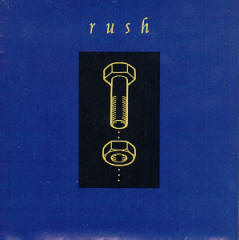
"Counterparts" proved that Rush could rock with the
best of them. To put this in a historical context, "Counterparts" was written during
the days of Grunge, a style replete with heavy guitar and feedback. Here were
bands like Nirvana, Pearl Jam, and Alice in Chains rocking hard. This helped to
pull Rush back to their roots even more than their previous two albums.
The results are magnificent. With a dirty mix
that doesn't give up sonic details, the band tears through the album in
a way they hadn't done since "Moving Pictures" or "Power Windows." You know you're
in for something different when you hear Neil Peart counting off, "1-2-3-4-1-2"
at the beginning, with a nice drum intro (one of his best beats).
Then comes Stick it Out, a type of Rush song we
haven't heard since Tom Sawyer. The guitar filled with feedback at the beginning
tells us how heavy this album is going to be. Cut to the Chase brings in some
interesting production, especially with the drums.
What's strange about this album is that it
actually gets better with each song, with the exception of Nobody's Hero, the
token ballad. But Between Sun and Moon, Alien Shore, Double Agent, and
Leave
That Thing Alone are simply brilliant.
Neil's drumming throughout the album is solid and
inventive, made even more organic by the unique raw production. He doesn't miss
an opportunity for interesting fills and details (listen to everything going on
in the instrumental Leave That Thing Alone).
Test
for Echo - Andyo rating: 2-1/2 stars out
of 4
Released
in September 1996

The title track Test for Echo starts out strong, with Neil playing some of his best drumming ever. And it seems like it's
getting even stronger with songs like Driven and Half the World.
But after the latter song, the songwriting becomes a little flat. It's still
good―just not as good as what we've heard from Rush.
This is the album where Neil switched to
traditional grip. He did so because he realized the stiffness that had
crept into his playing was ruining his feel. So Neil studied with a teacher, Freddie Gruber,
and Freddie taught him to lay back and groove again. It took Neil over a year to
build up this new technique enough to be able to play on a record. But after
listening to this album now, I feel like he still wasn't ready. Neil seemed to
want to become a Jazz drummer on this album―but that style doesn't fit with
Rush. At the very least, it was nice to hear Neil bringing in more nuance to his
playing, something that got stronger on the "Test for Echo" tour.
There are still some interesting songs on the
album. In addition to the first three, some of my favorites include Dog Years,
Resist, and Limbo.
This is also the album where Neil switched to DW drums, and there's an unmistakable deepness to the
drums now. The problem is
the mix is muddy, so the drums seem to get lost.
Different Stages - Andyo rating: 3 stars out of 4
Released
in November 1998

According
to Geddy Lee, this album was released to buy the band some more time, after
the tragic losses of Neil's daughter and wife.
With
"Different Stages," Rush put together a great live package that included
both the Counterparts and Test for Echo tours. It also includes a bonus third CD
concert from "A Farewell to Kings" tour.
While the
song selection is good, and the sound is good, there are some strange drum mix
issues that always turned me off to this album. There are also some tempo
issues in The Analog Kid that I always notice. I always think these
problems are there because Neil wasn't there to listen to mix.
Still,
there's all of 2112 and a great drum solo coming out of Leave That
Thing Alone. "Different Stages" is the third best Rush live album, after
"Rush in Rio" and "Exit... Stage Left."
Vapor Trails - Andyo rating: 3-1/2 stars out
of 4
Released
in May 2002

Rush had
taken off 5 or so years before they recorded this album, and they spent 14
months working on it.
The
results are superb. There's never been a stronger statement of Rush saying to
the world, "We're back!" Starting
One Little Victory off
with Neil's thunderous drumming was a great idea. This is one of Rush's best
songs.
Some of
my other favorites are Ceiling Unlimited, Ghost Rider, Secret
Touch, Nocturne, and Freeze. All of these songs represent
strong songwriting and a lyrical universality that hasn't appeared on Rush albums in a
long time.
The only
problem with the album is the production.
It's well documented on the Web that
this album suffers from bringing the levels up too loud. There's an unfinished
quality about the mix that sent some fans back to the store. I never felt that strongly about it, but I did think
there were problems.
In the
end, I don't care about the flaws. I was glad to have the band back
together writing aggressive songs, glad to hear Neil's drumming again.
Rush in Rio - Andyo rating: 4 stars out
of 4
Released
in October 2003
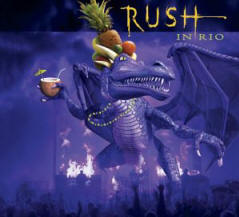
"Rush in Rio" is Rush's finest live achievement. It's
hard to separate the CD from the DVD (they are the same concert), except that
there are extra bootleg tracks of Between Sun and Moon and Vital Signs on the CD
and a different 5.1 mix on the DVD. All I
can say is the crowds in Rio put all other crowds to shame. They sing along to every
word and interact with the band throughout the concert in very unique ways. It's
clear that this is where some of the biggest Rush fans live.
The other interesting thing about this album is this
is the first time Rush has put out a full concert―the whole enchilada. It takes
three CDs, but who cares? The band is on
top of its game throughout the whole performance, especially Neil. It's
interesting to hear him re-imagine the drum parts for songs like By Tor and
the Snow Dog, Cygnus X-1, and Working Man.
For me, listening to this album brings back
memories of seeing Rush at that opening Hartford, CT, show with my friend
Monica, as well as the second night at Montage Mountain in Scranton, PN. The
second concert, while not as flawless as the first, had a kind of magic to it
that only comes around once in a while.
Feedback - Andyo rating: 3 stars out of 4
Release
date: June 29, 2004
 I
never thought I'd see the day when Rush would play covers. But all the songs on
"Feedback" are near and dear to the band's heart. For their 30th
Anniversary, the band wanted to give their
tribute to the songs that inspired them to start playing. I
never thought I'd see the day when Rush would play covers. But all the songs on
"Feedback" are near and dear to the band's heart. For their 30th
Anniversary, the band wanted to give their
tribute to the songs that inspired them to start playing.
The songs selection is eclectic. I have to admit,
I was only familiar with about half, but I've never been a huge fan of sixties
music.
The only issue I have with the album is the
production. At times, the drums sound like cardboard. It's as if the band was
trying to simulate the sixties sound, but I think it sounds just like that―a
simulation.
My favorites on the CD are: Summertime Blues,
The Seeker, and For What It's Worth. The songs sound even
better live! |